Last updated: March 30, 2023
Article
Mechanics Hall: Symbol of Pride and Industry (Teaching with Historic Places)
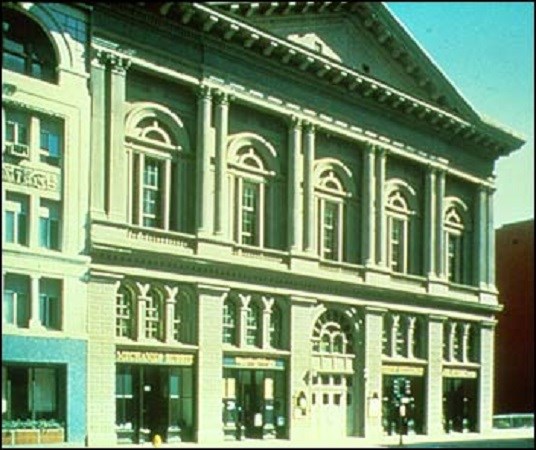
(Courtesy Mechanics Hall, Worcester, Massachusetts)
From its source in the hilly village of Worcester, Massachusetts to its ending in Pawtucket, Rhode Island, the Blackstone River played an important role in the history of New England as well as the country. Samuel Slater built the first successful water-powered cotton-spinning mill on the river in 1790, launching the Industrial Revolution in the United States. The once rural landscape of the Blackstone River Valley became filled with factories and mill towns seeking to take advantage of the river's power.
The advent of industrialization heralded changes in the workforce. In Worcester, workers formed the Mechanics Association in 1842 to help members develop the knowledge and skills to manufacture and run machinery in the mills. In 1857 they built Mechanics Hall to house educational and cultural activities. Featuring meeting rooms, a library, and two halls, the building became a hub of activity, drawing speakers from Charles Dickens to Susan B. Anthony. The superb acoustics of Mechanics Hall would attract orchestras, bands, and renowned performers from Enrico Caruso to Ella Fitzgerald, Yo Yo Ma to Mel Torme. Culture, like the river, would enrich the lives of the people of Worcester.
About This Lesson
This lesson plan is based on the National Register of Historic Places registration file, "Mechanics Hall," and other sources on the Industrial Revolution and the Blackstone River Valley. Mechanics Hall: A Symbol of Pride and Industry was written by Jack Whittaker, Park Ranger, Blackstone River Valley National Heritage Corridor. The lesson was edited by Jean West, education consultant, and the Teaching with Historic Places staff. TwHP is sponsored, in part, by the Cultural Resources Training Initiative and Parks as Classrooms programs of the National Park Service. This lesson is one in a series that brings the important stories of historic places into classrooms across the country.
Where it fits into the curriculum
Topics: This lesson will help students gain a deeper understanding of the dynamic shift from farm to factory during the 19th century in the area of Worcester, Massachusetts. It can be used in American history, social studies, and geography courses in units on the industrialization of New England.
Time period: 19th century
United States History Standards for Grades 5-12
Mechanics Hall: Symbol of Pride and Industry relates to the following National Standards for History:
Era 4: Expansion and Reform (1801-1861)
-
Standard 2A- The student understands how the factory system and the transportation and market revolutions shaped regional patterns of economic development.
-
Standard 2B- The student understands the first era of American urbanization.
-
Standard 4B- The student understands how Americans strived to reform society and create a distinct culture.Era 6: The Development of the Industrial United States (1870-1900)
-
Standard 2C- The student understands how new cultural movements at different social levels affected American life.
Curriculum Standards for Social Studies
(National Council for the Social Studies)
Mechanics Hall: Symbol of Pride and Industry relates to the following Social Studies Standards:
Theme I: Culture
-
Standard A - The student compares similarities and differences in the ways groups, societies, and cultures meet human needs and concerns.
-
Standard C - The student explains and give examples of how language, literature, the arts, architecture, other artifacts, traditions, beliefs, values, and behaviors contribute to the development and transmission of culture.
Theme II: Time, Continuity and Change
-
Standard B - The student identifies and uses key concepts such as chronology, causality, change, conflict, and complexity to explain, analyze, and show connections among patterns of historical change and continuity.
-
Standard D - The student identifies and uses processes important to reconstructing and reinterpreting the past, such as using a variety of sources, providing, validating, and weighing evidence for claims, checking credibility of sources, and searching for causality.
Theme III: People, Places and Environments
-
Standard B - The student creates, interprets, uses, and distinguishes various representations of the earth, such as maps, globes, and photographs.
-
Standard D - The student estimates distance, calculate scale, and distinguish's other geographic relationships such as population density and spatial distribution patterns.
-
Standard G - The student describes how people creates places that reflect cultural values and ideals as they build neighborhoods, parks, shopping centers, and the like.
Theme V: Individuals, Groups, and Institutions
-
Standard B - The student analyzes group and institutional influences on people, events, and elements of culture.
-
Standard C - The student describes the various forms institutions take and the interactions of people with institutions.
-
Standard G - The student applies knowledge of how groups and institutions work to meet individual needs and promote the common good.
Theme VII: Production, Distribution and Consumption
-
Standard A - The student gives and explain examples of ways that economic systems structure choices about how goods and services are to be produced and distributed.
-
Standard D - The student describes a range of examples of the various institutions that make up economic systems such as households, business firms, banks, government agencies, labor unions, and corporations.
Theme VIII: Science, Technology and Society
-
Standard A - The student examines and describes the influence of culture on scientific and technological choices and advancement, such as in transportation, medicine, and warfare.
Theme X: Civic Ideals and Practices
-
Standard J - The student examine strategies designed to strengthen the "common good," which consider a range of options for citizen action.
Objectives for students
1) To explain the Blackstone River Valley's role in the early industrialization of the United States.
2) To determine how various transportation methods impacted the industrial development of Worcester, Massachusetts.
3) To define the role of mechanics in the economic and cultural development of Worcester.
4) To examine the range of cultural, civic, and social activism programs presented at Mechanics Hall.
5) To conduct research on historic structures in their own community.
Materials for students
The materials listed below either can be used directly on the computer or can be printed out, photocopied, and distributed to students. The maps and images appear twice: in a smaller, low-resolution version with associated questions and alone in a larger version.
1) two maps showing the Blackstone River Valley;
2) three readings about the mechanics of Worcester and Mechanics Hall;
3) two drawings of mechanics at work;
4) two illistrations of lecture and concert ads;
5) four photos of Mechanics Hall.
Visiting the site
Mechanics Hall, included in the Blackstone River Valley National Heritage Corridor, is located in Worcester, Massachusetts, off of I-290. Take Exit 16 (Central Street) and turn left onto Worcester Center Boulevard. Turn right onto Foster Street, then right onto Waldo Street. Visitors can tour Mechanics Hall and see the historic Worcester Organ and its 3,504 pipes. For a calendar of events and tour information, contact Mechanics Hall, 321 Main Street, Worcester, MA 01608, or visit the Mechanics Hall web site.
Getting Started
Inquiry Question
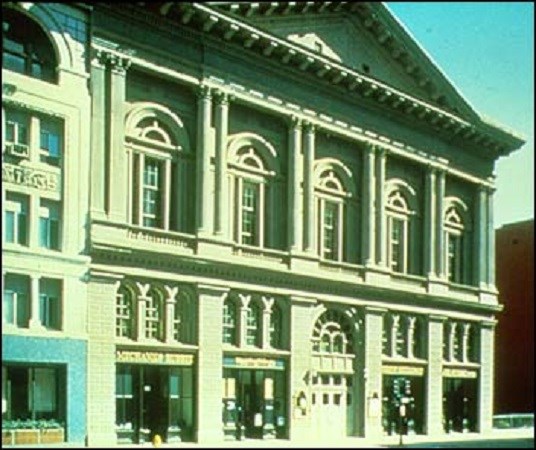
What purpose do you think this structure was built to serve?
Setting the Stage
The Blackstone River, stretching from Worcester, Massachusetts, to Pawtucket, Rhode Island, played a crucial role in the development of the surrounding area. In 1790, Pawtucket witnessed the birth of the American Industrial Revolution when Samuel Slater built the first successful water-powered textile mill. By 1814, water-powered mills could be found at all the readily available dam sites in the Blackstone River Valley. These mills and the villages that grew up around them transformed the previously agrarian landscape.
The rapid growth of the textile mills of New England created a need for more sophisticated tools and metal components. This need was met by an increasing number of metal working shops in the northern (Worcester, Massachusetts) end of the Blackstone River Valley. Everything from giant boilers and turbines to wire, precision tools, and fine cutlery was designed and fabricated in dozens of factories throughout Worcester.
The skilled workers who operated the machinery and created the products were known as "mechanics" (men who made things). Some of these mechanics had become successful businessmen and civic leaders in their communities by the middle of the 19th century. Mechanics in many New England towns, including Worcester, formed mechanics organizations to help members develop the knowledge and skills necessary to work in the mills. These workers prided themselves on their constant pursuit of knowledge. A sense of pride and community prompted members of the Mechanics Association in Worcester to construct a magnificent meeting hall in 1857. Members used the facility to hold meetings and lectures, to conduct classes, and to showcase their products and skills. As a place for learning work-related skills and experiencing cultural events, Mechanics Hall was a tribute to the new kind of worker in an industrialized world.
Locating the Site
Map 1: New England.
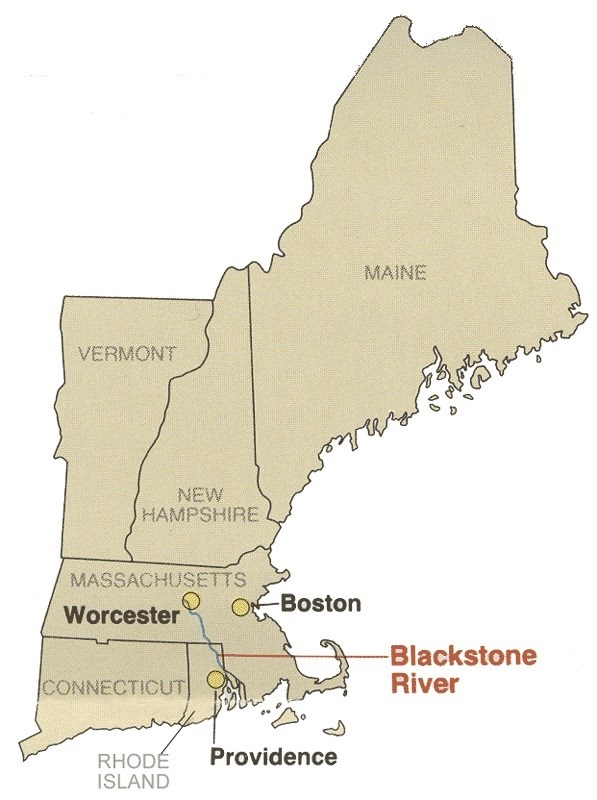
National Park Service.
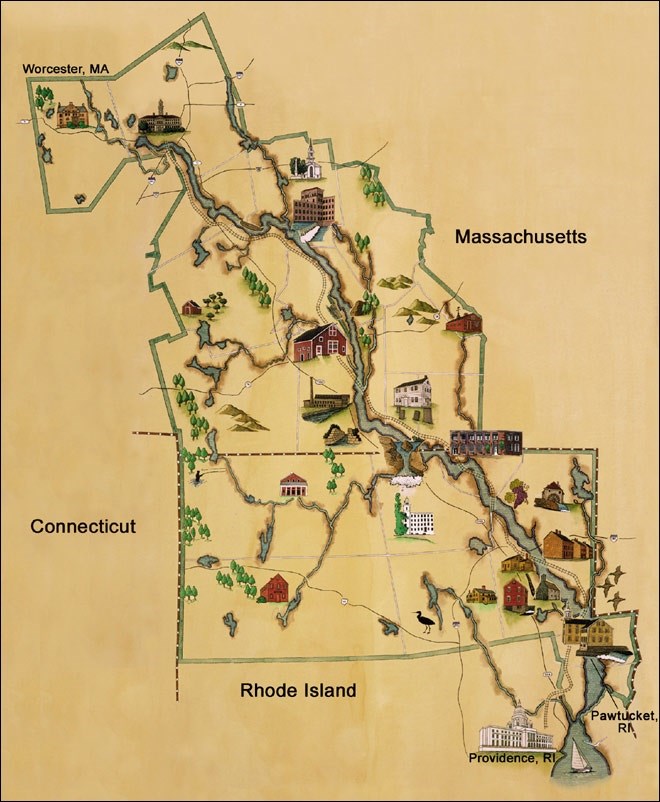
(Blackstone River Valley National Heritage Corridor)
The Blackstone River provided the waterpower for the birth of industry in America with its 438-foot drop over a 46-mile length.
Questions for Maps 1 and 2
1. Based on Map 1, how would you describe the Blackstone River Valley's location?
2. Trace the route of the Blackstone River on Map 2. Why was the river so important to the region?
3. Locate Pawtucket, Rhode Island. Why is Pawtucket considered the birthplace of the American Industrial Revolution? If needed, refer to Setting the Stage.
4. Locate Worcester, Massachusetts. What role did it play in the economy of the region in the 19th century?
Determining the Facts
Reading 1: Mechanics: A Rising Middle Class
The age of glaciers left New England with many steeply falling streams that were well suited to water-powered activities. Soon after settling the region, the colonists of New England began to build water mills to process grain, lumber, and iron-goods. However, harsh weather often limited mobility, and early transportation routes were primitive and unreliable. As a result, manufacturing remained isolated and self-sufficient.
The situation changed drastically following Samuel Slater's construction of a water-powered cotton carding and spinning mill in 1790 in Pawtucket, Rhode Island. The Blackstone River Valley became a center for industrial growth and technological innovation. Textile, tool, machine, hat, and shoe factories filled the region. Increased investment and industrialization led to large urban centers of production linked by improving transportation. Worcester, Massachusetts, is an example of this change in the American scene.
Worcester did not have streams for large mills or reliable, cheap transportation, so it remained rural in character after the lower Blackstone River Valley began to experience industrial development. Transportation was finally improved by the completion of the Blackstone Canal in 1828. The canal paralleled the Blackstone River and connected tiny Worcester, Massachusetts, to Providence, Rhode Island, a major port. Although it could only be used seasonally, the canal triggered rapid growth in the previously agricultural village. Worcester's population grew from less than 3,000 in 1819 to 7,000 in 1840.
Improvements in the steam engine provided better solutions to Worcester's power and transportation problems. The steam engine generated power for factories, while the steam locomotive offered fast, inexpensive, year-round transportation. Major rail lines completed in the 1830s and 1840s connected Worcester to distant markets. Population growth accelerated, and by 1890, Worcester's population numbered 80,000.
At the beginning of the Industrial Revolution, mill owners hired farmers and agricultural workers from nearby. These laborers had to master the discipline of working on a factory schedule, rather than the rhythms of the agrarian calendar, and learn how to run the complicated machinery in the mills. The ever increasing need for more sophisticated material, machinery, and tools in the rapidly developing industries challenged early craftsmen. The most successful of these early "mechanics" soon became inventors, entrepreneurs, and directors of large scale enterprises. They attained a social status equal to that of the earlier aristocrats and landed gentry.
Among the most successful entrepreneurs was Ichabod Washburn (1798-1868). The young man arrived in Worcester from his blacksmithing apprenticeship in nearby Leicester "with no money, but a fortune in my hands."¹ Washburn made his fortune by inventing industrial machinery, most notably the drawing block, which revolutionized the method for making wire. He and an associate formed the Washburn and Moen Company, which became a world leader in manufacturing wire products such as carding wire for cotton mills, piano and corset wires, and telegraph and barbed wire. This self-made man was a generous philanthropist who supported the abolitionist and temperance movements, gave generously to Lincoln College (renamed Washburn College) and Worcester Polytechnic Institute, and helped to found Worcester's Mechanics Association.
In late 1841, some of the mechanics of Worcester decided to found an association to help educate the city's industrial workers. They formed a committee to draft a constitution for the organization; Ichabod Washburn served as chairman. By February 1842, the Worcester County Mechanics Association had attracted more than a 100 members. Like many mutual aid societies, the Mechanics Association provided assistance to disabled members as well as to the widows and families of deceased members. The Association was particularly active in educating its members. It collected technical books and manuals for a library that members could use to help expand their knowledge of machinery and manufacturing procedures. Members could take individual classes to learn skills such as mechanical drawing and blueprint reading or even follow a diploma course. The Association also held Mechanics Fairs, public exhibitions of mechanical and manufactured arts featuring new inventions and products. Members and the general public could also attend debates, abolition and temperance lectures, and scientific demonstrations sponsored by the Mechanics Association.
Questions for Reading 1
1. Why did Worcester remain rural after other parts of the Blackstone River Valley became industrialized? How and when did this change?
2. What did the term "mechanic" mean in the 19th century? What does it mean today?
3. What benefits did members of the Mechanics Association enjoy? What benefits did the community of Worcester enjoy from having a substantial number of mechanics as residents?
Reading 1 was compiled from standard references about the Industrial Revolution in the United States; Henry T. Cheever, Autobiography And Memorials Of Ichabod Washburn, Showing how a great business was developed and large wealth acquired for the uses of benevolence (Boston: D. Lothrop and Company, 1878); and Margaret A. Erskine, Mechanics Hall (Worcester, Mass.: Worcester Bicentennial Commission, 1977).
¹ Henry T. Cheever, Autobiography And Memorials Of Ichabod Washburn, Showing how a great business was developed and large wealth acquired for the uses of benevolence (Boston: D. Lothrop and Company, 1878), 42.
Determining the Facts
Reading 2: Mechanics Hall
By the middle of the 19th century, the large landowners, town merchants, and legal professionals who had been the most important forces in pre-Revolutionary, rural Worcester County found that there was a new force in society. Newly wealthy industrialists entered the upper classes, while substantial numbers of skilled mechanics entered the middle class. These mechanics contributed to the general prosperity of society and were justly proud of their hard work and public spirit. In Worcester, the Mechanics Association wanted a permanent meeting place and a public commemoration of their skill, industry, and achievements.
By 1851, it became clear that the Worcester County Mechanics Association needed a larger space for its classes and library, but also for holding lectures, debates, and various entertainments. Ichabod Washburn was selected chairman of the building committee for Mechanics Hall. The committee of strong-minded, successful men drawn from a membership of skilled and ingenious mechanics (including many from the building trades) was a difficult group to satisfy. They selected the Italian Renaissance Revival design of a local architect, Elbridge Boyden, for the hall and broke ground in July 1855.
Members of the Mechanics Association constructed the building, raising its timbers, mortaring its bricks, finishing paint to imitate limestone, and applying decorative cast iron on the facade. When completed, Mechanics Hall was the tallest and largest building in Worcester, a showplace of innovative building techniques and mechanical systems that were fitting monuments to the mechanics of Worcester. The hall opened on March 19, 1857, with speeches, performances by two bands, and an evening concert by the Boston Orchestral Union. Cost over-runs led to an unforeseen debt of $104,000, but partial payment of outstanding bonds and donations from prominent Worcester citizens (including Washburn) secured the financial future both of the Mechanics Association and Mechanics Hall.
Mechanics Hall featured a large concert hall on the third floor. Its perfect acoustics enabled audiences to hear speakers' voices and music distinctly without benefit of the as-yet-invented microphone or electronic amplifier. Workers framed the end of the hall for a pipe organ, which was subsequently installed in 1863. The smaller Washburn Hall and rooms for the use of the Mechanics Association occupied the second floor. Four stores, which were rented out by the Association to generate income, occupied the street level.
Certainly, Mechanics Hall gave the Mechanics Association a place to meet, conduct classes, keep its library, and hold exhibitions. Yet, from the day it was dedicated, Mechanics Hall also became the center of Worcester's cultural life. Two years after it opened, in 1859, it became home to the Worcester Music Festival, now the oldest musical festival in the nation. The mechanics charged the Worcester County Music Association only one dollar per season for the use of the hall for rehearsals and performances because they wanted to bring culture to their community. Since its opening the superb acoustics of the hall have attracted the world's finest musicians, whether classical, jazz, or popular. Among those to perform in the hall have been Enrico Caruso, Antonin Dvorak, Yo Yo Ma, Itzak Perlman, Mel Torme, and Ella Fitzgerald. An additional attraction to keyboard artists has been the 3,504-pipe Hook organ, the world's only surviving 19th-century four-keyboard organ. Mechanics Hall was not simply a concert hall. Distinguished authors who lectured there included Henry David Thoreau, Ralph Waldo Emerson, Charles Dickens, and Mark Twain. By the turn of the 20th century, it had screened early motion pictures as well.
Mechanics Hall also hosted political meetings and rallies in Worcester. The Mechanics Association would rent the hall out whether it approved of the groups' beliefs or not. Henry Ward Beecher and other abolitionists crusaded in Mechanics Hall for the emancipation of slaves; Susan B. Anthony and Elizabeth Cady Stanton would subsequently crusade for women's suffrage. Presidents William McKinley, Theodore Roosevelt, William Taft, and Woodrow Wilson all addressed Worcester audiences at Mechanics Hall.
Yet, above all, Mechanics Hall became the place for the people of Worcester to come together. When Abraham Lincoln was assassinated in 1865, the people of Worcester memorialized him at Mechanics Hall. Civic or religious groups could hold fund-raising events in the building free of charge, courtesy of the Mechanics Association. Departing and returning soldiers were honored within the building's walls. However, by the mid-20th century, downtown Worcester had declined, and the aging building fell into disfavor as a meeting place. Mechanics Hall was rented out for sporting events such as boxing, wrestling, basketball, and roller-skating. The building continued its decline, and trustees of the dwindling Mechanics Association sought to sell the property. When urban renewal threatened the hall with destruction, the Worcester Heritage Society stepped in. The community rallied around Mechanics Hall once again, raising $5 million for its restoration in 1977. In reversing the decline of Mechanics Hall, Worcester halted the decline of its downtown, and the city experienced a renaissance.
Questions for Reading 2
1. How did the mechanics contribute to Mechanics Hall's construction?
2. How was Mechanics Hall a multi-use facility? What types of activities took place here?
3. Define the term "acoustics." Experiment with a partner to identify what room in your home has the best acoustics.
4. Community planners sometimes have to decide between tearing structures down and building something completely new or renovating historic buildings. What did Worcester gain by deciding to restore and preserve Mechanics Hall that it would not have gained by bulldozing it?
Reading 2 was compiled from Mechanics Hall informational brochures; Margaret A. Erskine, Mechanics Hall (Worcester, Mass.: Worcester Bicentennial Commission, 1977); and John Herron, "Mechanics Hall" (Worcester County, Massachusetts) National Register of Historic Places Nomination Form, Washington, D.C.: U.S. Department of the Interior, National Park Service, 1972.
Determining the Facts
Reading 3: Excerpts from the Massachusetts Spy
The Massachusetts Spy was a weekly newspaper founded by Isaiah Thomas in Boston, Massachusetts. The newspaper moved to Worcester on the eve of the American Revolution and was renamed the Worcester Spy. In 1857, the newspaper reported the dedication of Mechanics Hall and some of its early programs, as well as local, national, and world news.
Massachusetts Spy, March 25, 1857
THE DEDICATION BALL at Mechanics Hall last evening, brought forth the greatest display of "beauty and fashion" that has been seen in this city. About one thousand persons attended. The refreshments were provided by C. Forbush & Co., and were served up in "Washburn Hall." The tables were spread with great taste and elegance. The viands were choice, and the whole affair did great credit to C. Forbush & Co., the caterers. The music was by the Boston Orchestral Union—the same band which gave the concert on Thursday evening. Of course it was first rate.
Massachusetts Spy, April 22, 1857
ANTI SLAVERY CONVENTION —The Worcester County (South Division) Anti-Slavery Society held a quarterly session in this city on Sunday, at Horticultural Hall. In the morning, interesting speeches, in their peculiar vein, were made by Wm. Lloyd Garrison and Stephen S. Foster, and in the afternoon, Wendell Phillips made one of his eloquent and powerful addresses.
At the evening session, which was held at Mechanics' Hall, Wendell Phillips spoke again, and made the speech of the session, to an auditory of some two thousand. Mechanics' Hall is the place to hear Wendell Phillips to advantage.
The Oratorio of the Creation, performed by the Mozart Society, at Mechanics' Hall, on Thursday evening, afforded further demonstrative evidence of the necessity which had arrived for just such a hall in this city, and of the great convenience it will be to our citizens. Every seat, in all parts of the house, was filled, numbers were obliged to stand, and some, we are informed, who had purchased tickets, but were unable to obtain seats, returned their tickets and received the price back again. The performance was a most successful one. We have no room, if we had the capacity, to criticize it, but we cannot omit to say that the efforts of Mrs. Allen and Misses Fiske and Whiting were most favorably received by the audience. It was very ably conducted by Mr. Edward Hamilton, who added new honors to those already won by him.
Questions for Reading 3
Massachusetts Spy, March 25, 1857
1. How many people attended the Dedication Ball?
2. What are "viands"?
3. Compare this article with one in a contemporary newspaper or newscast describing an opening night. How are the reports similar? How are they different?
Massachusetts Spy, April 22, 1857
1. What program was presented at Mechanics Hall on Thursday?
2. Who spoke at an Anti-Slavery Convention in Horticultural Hall on Sunday?
3. What is an "auditory"?
4. Do these two articles support the reporters' opinion that by 1857, Worcester needed a place like Mechanics Hall? Explain your answer.
Reading 3 was compiled from transcriptions of articles from the Massachusetts Spy in the collection of the American Antiquarian Society of Worcester, Massachusetts.
Visual Evidence
Drawing 1: Boilermakers at work.
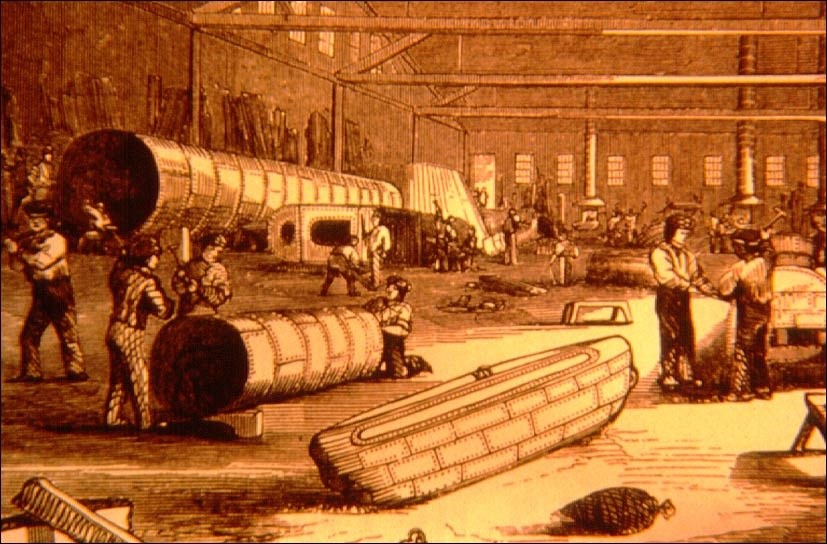
(Courtesy Mechanics Hall, Worcester, Massachusetts)
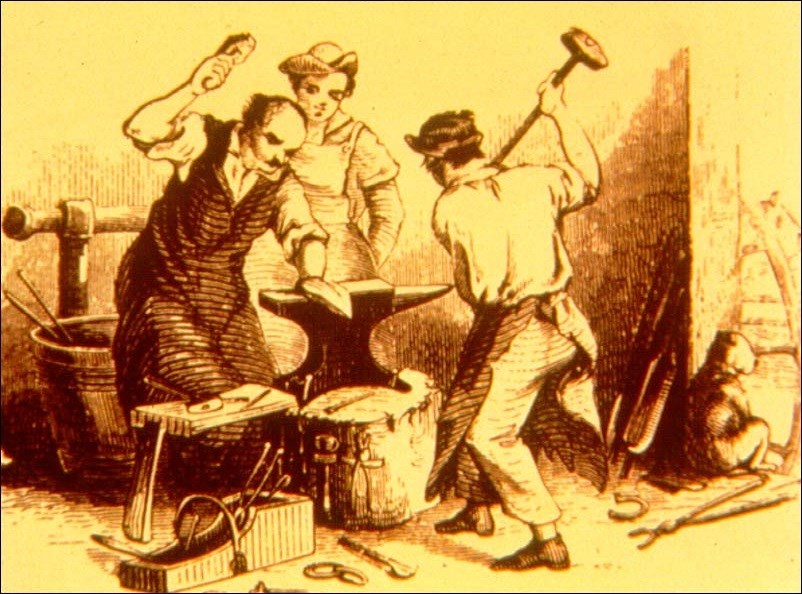
(Courtesy Mechanics Hall, Worcester, Massachusetts)
A blacksmith is a person who forges and shapes iron with an anvil and hammer.
Questions for Drawings 1 & 2
1. What can you learn about 19th-century mechanics by studying Drawings 1 and 2?
2. What are some of the tools being used by the mechanics in Drawing 2?
3. Why would boilermaking and blacksmithing have been important in the Blackstone River Valley in the 19th century?
Visual Evidence
Illustration 1: Advertisement for Women's Suffrage Movement lecture, December 7, 1867.
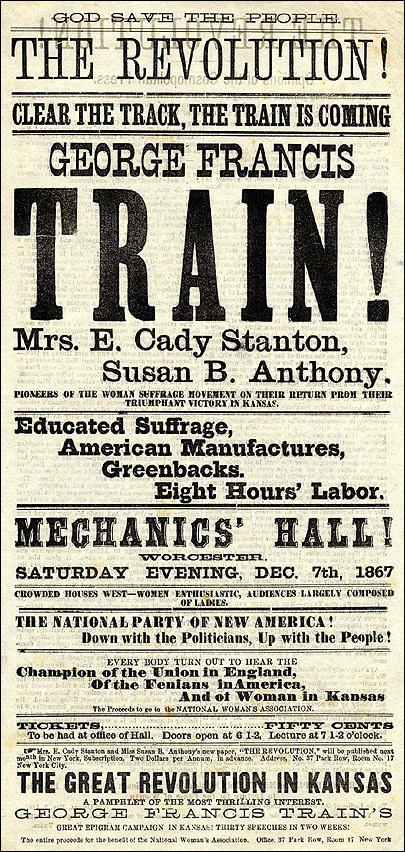
George Francis Train was an influential businessman and writer who supported women's suffrage. In October 1867, Train, Elizabeth Cady Stanton, and Susan B. Anthony gave lectures in support of women's suffrage in several cities in Kansas. Afterwards, they
George Francis Train was an influential businessman and writer who supported women's suffrage. In October 1867, Train, Elizabeth Cady Stanton, and Susan B. Anthony gave lectures in support of women's suffrage in several cities in Kansas. Afterwards, they began a cross country lecture tour.
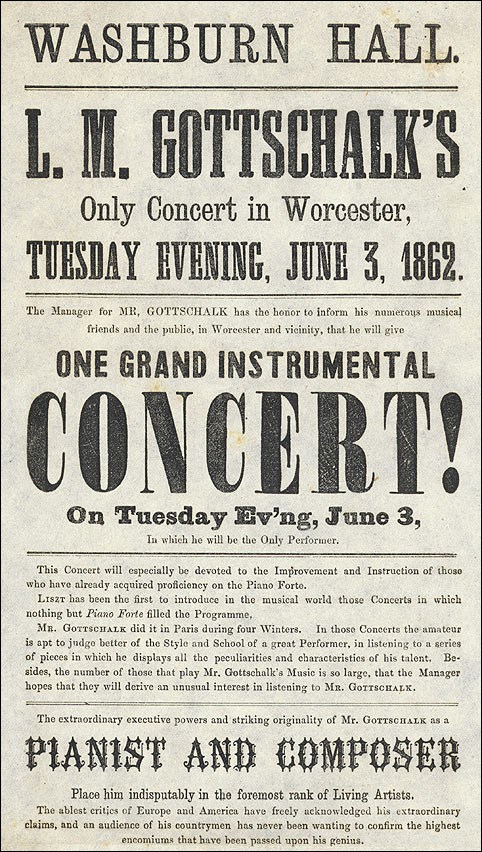
(Courtesy, American Antiquarian Society)
Questions for Illustrations 1 & 2
1. Who were the speakers at the lecture advertised in Illustration 1? What topics other than women's suffrage were addressed at the lecture? What was the purpose of the tour?
2. According to Illustration 2, what type of concert will Mr. Gottschalk be presenting? Why might a program like his be held in Washburn Hall?
3. How do these advertisements represent the diversity of activities held at Mechanics Hall? How do they differ from advertisements for concerts or lectures you might see today?
Photo 1: The Mechanical and Electrical Exposition, Mechanics Hall, 1909.
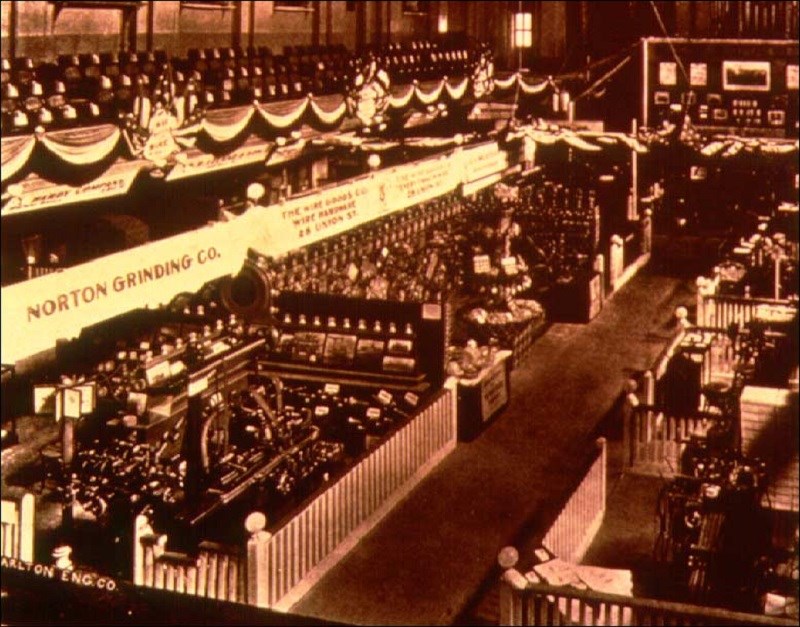
(Courtesy Mechanics Hall, Worcester, Massachusetts)
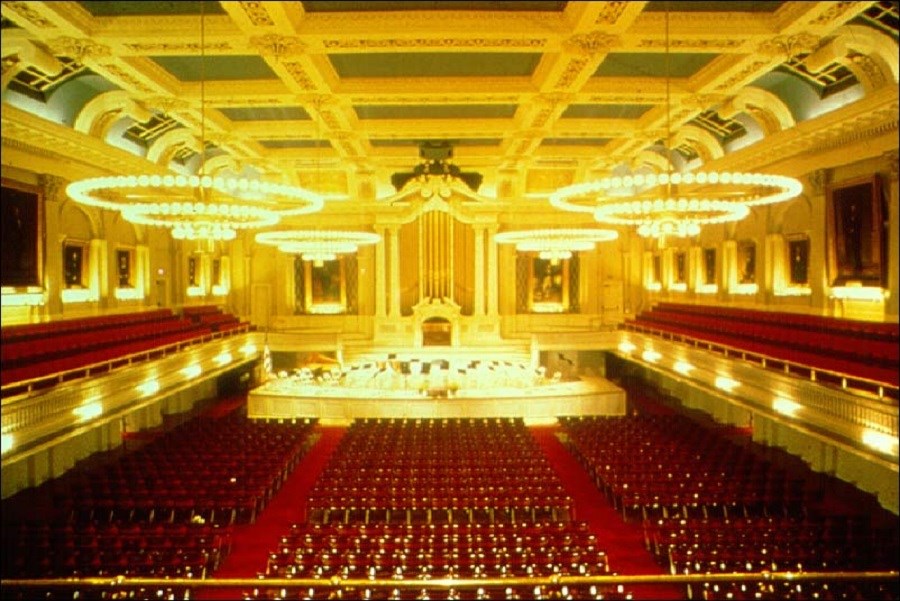
Questions for Photos 1 & 2
1. What do you think was the purpose of the Mechanical and Electrical Exposition? Why would it have been held at Mechanics Hall?
2. How would you describe the main hall based on Photo 2? What types of events do you think could be held there today?
Visual Evidence
Photo 3: Mechanics Hall, before restoration.
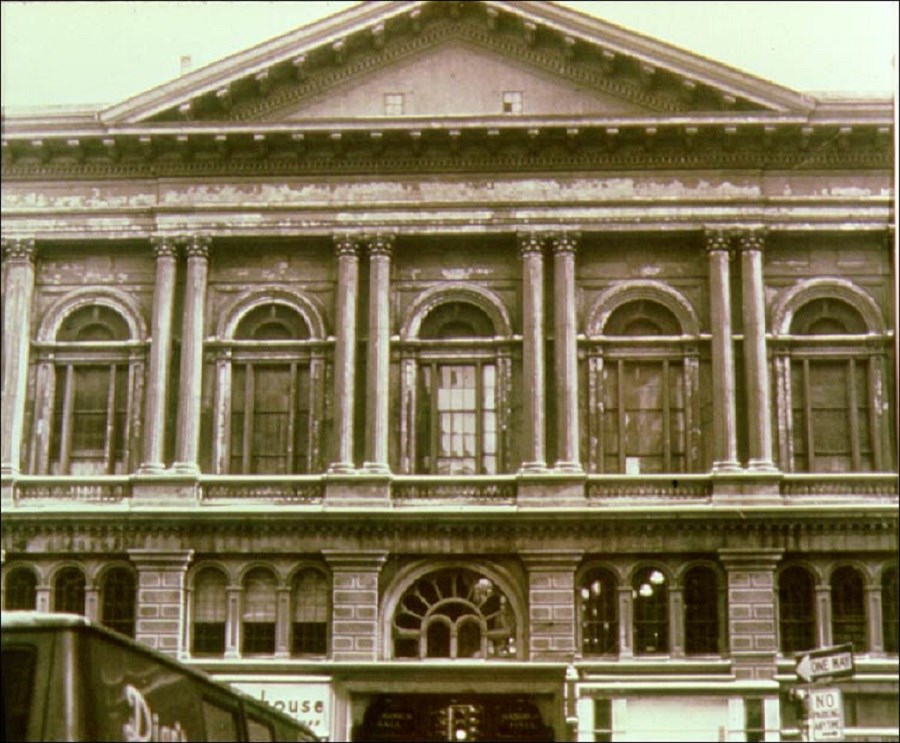
(Courtesy Mechanics Hall, Worcester, Massachusetts)

Questions for Photos 3 & 4
1. Compare Photos 3 and 4. How does the exterior of Mechanics Hall differ from Photo 3 to Photo 4? What are some possible reasons why the building deteriorated? (Refer to Reading 2, if necessary.)
2. Why do you think the people of Worcester chose to restore Mechanics Hall to its previous appearance rather than change it or demolish it entirely and build a new structure?
Putting It All Together
The following activities engage students in a number of ways that let them discover the importance of meeting places.
Activity 1: Meeting Places
Every New England village had a meetinghouse. Often they were used for religious activities, but they had other functions as well. As population centers grew, people needed larger meetinghouses. Mechanics Hall architect Elbridge Boyden had constructed a number of meetinghouses prior to receiving the commission of the Mechanics Association. He drew on his earlier experiences to provide state-of-the art acoustics, ventilation, and amenities to patrons of Mechanics Hall. Ask students to conduct research and prepare a short report on public meeting spaces in their community using the following questions as a guide:
1. What location is available in your community for large groups to gather?
2. Does your town or a nearby urban center have a concert hall, auditorium, theater, arena, stadium, or convention center? If not, is one under discussion or construction?
3. Do some public facilities have multiple uses, for example concerts and sports? What is the advantage of having a multi-use public meeting place?
4. What are the purposes for building convention centers in urban areas? If there is one in your community or region, has it accomplished its purpose? Explain.
Activity 2: Technology and Community
When television brought sports to a wide audience, Mechanics Hall lost business, yet attendance at many stadiums grew. Similarly, when television brought music and dance to a wide audience, some concert halls folded, but overall attendance at cultural performances grew. Recent developments in mass communication, especially the Internet, have sociologists concerned that public meeting places may become obsolete. Divide the class into two large groups. Have each group complete one of the following activities and then hold a classroom discussion based on the findings:
1. How did television impact your community? What meeting places thrived? What meeting places declined? Evaluate whether television made people in your community more isolated from each other or whether it brought them together.
2. Compare the educational, cultural, political, and civic benefits of a brick and mortar meeting place, such as Mechanics Hall, with the virtual meeting place of the Internet. How are they similar? What advantages does a real meeting place offer over the Internet? What advantages does the Internet offer over a building?
Activity 3: Local Research
Ask students to investigate the area in which you live and compile a list of historic structures or sites. Divide the class into five teams. Each team should select one site, conduct research into its history, and prepare a report on the site. The report may take the form of a written essay, an oral presentation or skit, a poster or computer display. Students may use any of the following research resources available to them:
1. Interview the current resident and/or owner of the site, or someone who presently works there. Locate older members of the community who may be able to contribute recollections, old photographs, or vintage news clippings to the investigation.
2. Check the school library, including vertical files, for information about the site.
3. Go to the public library and check out the local history and genealogical resources there, as well as vertical files, local periodicals that may be on microfilm or microfiche, and Internet sources about the community.
4. Contact the historical society or historical preservation commission in the community for information about the site.
5. Public records, including old maps, available at the county courthouse or town clerk's office may help trace changes in ownership, subdivision of land, and building modifications.
6. Determine if a nomination form for the National Register of Historic Places exists for your site. For more information, visit the National Register of Historic Places web site.
When finished with their research, students may wish to share their findings beyond the classroom:
1. If the community has a tour of historical homes, students may wish to volunteer to act as docents for sites into which they have conducted research.
2. Students may offer to make a presentation of their findings to the historical society or local architectural preservation group; they may wish to deposit copies of their reports with these groups, especially if there is an ongoing effort to nominate the site to the National Register.
Mechanics Hall: Symbol of Pride and Industry--
Supplementary Resources
By looking at Mechanics Hall: Symbol of Pride and Industry, students will learn about the Industrial Revolution and the mechanics whose skill not only ran the factories but also built enduring institutions, including Worcester's Mechanics Hall. Those interested in learning more will find that the Internet offers a variety of interesting materials.
Blackstone River Valley National Heritage Corridor
The Blackstone River Valley National Heritage Corridor's website introduces students to a new kind of national park. Although the Federal Government does not own the 250,000-acre region, the National Park Service, state governments, local governments, businesses, environmental and historic organizations, and individuals are working to protect the special identity of this region.
Mechanics Hall
Mechanics Hall is still the cultural center of modern Worcester, Massachusetts. Visit the Hall's website for a full calendar of events, including concerts, seminars, tours, and outreach programs to teachers and students.
Slater Mill Museum
Slater Mill is a Living History museum where visitors can take part in the lives of the New England villagers, inventors, artisans, and entrepreneurs who created the American Industrial Revolution. The museum's website introduces students to the Pawtucket, Rhode Island birthplace of the Industrial Revolution. They can learn about Samuel Slater and see the mill he built on the Blackstone River.
American Antiquarian Society
The American Antiquarian Society (AAS) is an independent research library founded in 1812 in Worcester, Massachusetts. The library's collections document the life of America's people from the colonial era through the Civil War and Reconstruction. The Society's website features on-line exhibitions of materials in its collection.
